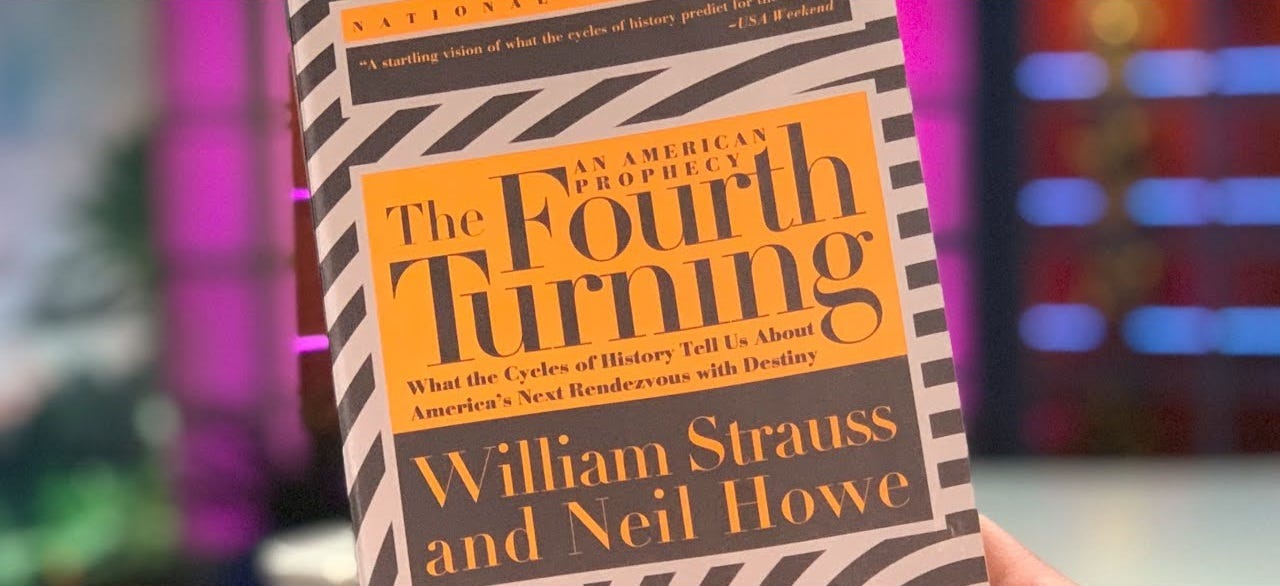The Fourth Turning, a synopsis: what are the implications for Bitcoin?
How generational theory predicts the future of money
The book “The Fourth Turning” (1997) by William Strauss and Neil Howe presents a bold theory of history that unfolds in recurring cycles, or “saecula,” each lasting about 80 to 100 years (the average span of a human lifetime). These cycles are divided into four "turnings" (akin to seasons), which that repeat over generations:
High (Spring): A period of strong institutions and collective confidence. Think the period after World War 2 and the prosperity of the time.
Awakening (Summer): A spiritual upheaval where individuals seek autonomy and values shift. Think the swinging 60’s and free love.
Unravelling (Autumn): Institutions weaken, individualism rises, and society becomes fragmented. Think Nixon, Thatcher and Regan.
Crisis (Winter): A defining era of upheaval that reshapes society, institutions, and national identity. We are currently in the period of crisis.
The book argues that America is now in the Fourth Turning, a time of crisis (starting around 2008 and likely ending ~2030), marked by economic distress, institutional collapse, polarisation, and generational conflict. These periods tend to culminate in major transformations, historically through wars, revolutions, or resets.
🧠 Key themes
1. The Saeculum: understanding historical cycles
The authors define the "saeculum" as a four-part generational cycle spanning roughly a century. Each turning reflects the traits of four generational archetypes: Prophets, Nomads, Heroes, and Artists.
2. The four turnings explained
Each turning reshapes society based on generational behaviours and responses to past conditions. Historical parallels are drawn to events like the American Revolution, Civil War, and World War II.
3. The crisis ahead (a Fourth Turning)
The authors forecast a coming upheaval (which is now here) involving economic distress, geopolitical instability, or civil unrest. It is during this time that new institutions are born and old ones are replaced.
4. Generational roles
The "Boomers," "Gen X," "Millennials," and "Gen Z" all play different roles in the unfolding crisis and eventual rebuilding.
5. The rebirth of civic life
After the crisis, a new societal order emerges, shaped by the values and experiences of the rising generation.
₿ Hypothesising the impact on Bitcoin
If we accept that we are in the midst of a Fourth Turning, a time when institutions are questioned, trust erodes, and society seeks new systems, then Bitcoin may not just survive this upheaval but thrive because:
🔥 1. Collapse of institutional trust
People are losing faith in governments, central banks, and traditional finance. Bitcoin represents a thrustless, decentralised alternative, exactly the kind of innovation that finds momentum in crisis.
💸 2. Fiat currency instability
Fourth Turnings are often marked by economic resets, hyperinflation, or debt crises. Bitcoin’s fixed supply and decentralised issuance has become, and is likely to continue to be a hedge against fiat devaluation.
🧑🤝🧑 3. Rise of digital generations
Millennials and Gen Z, more digitally native and sceptical of legacy systems, are more open to non-traditional forms of money. This aligns perfectly with Bitcoin adoption accelerating during periods of generational change.
🛠 4. New institutions from the ashes
Just as previous Fourth Turnings led to the creation of the modern nation-state, central banking, and the welfare state...the next cycle could see crypto-native institutions and digital monetary frameworks rise in prominence.
📝 Conclusion
The Fourth Turning isn’t just a book about history, it’s a lens for interpreting our chaotic present and uncertain future. If history indeed moves in cycles, and a generational crisis is upon us, Bitcoin may emerge not just as an investment but as part of the architecture of a new era. HODL on.



We are definitly in the fourth turining right now. Kaos growing daily.